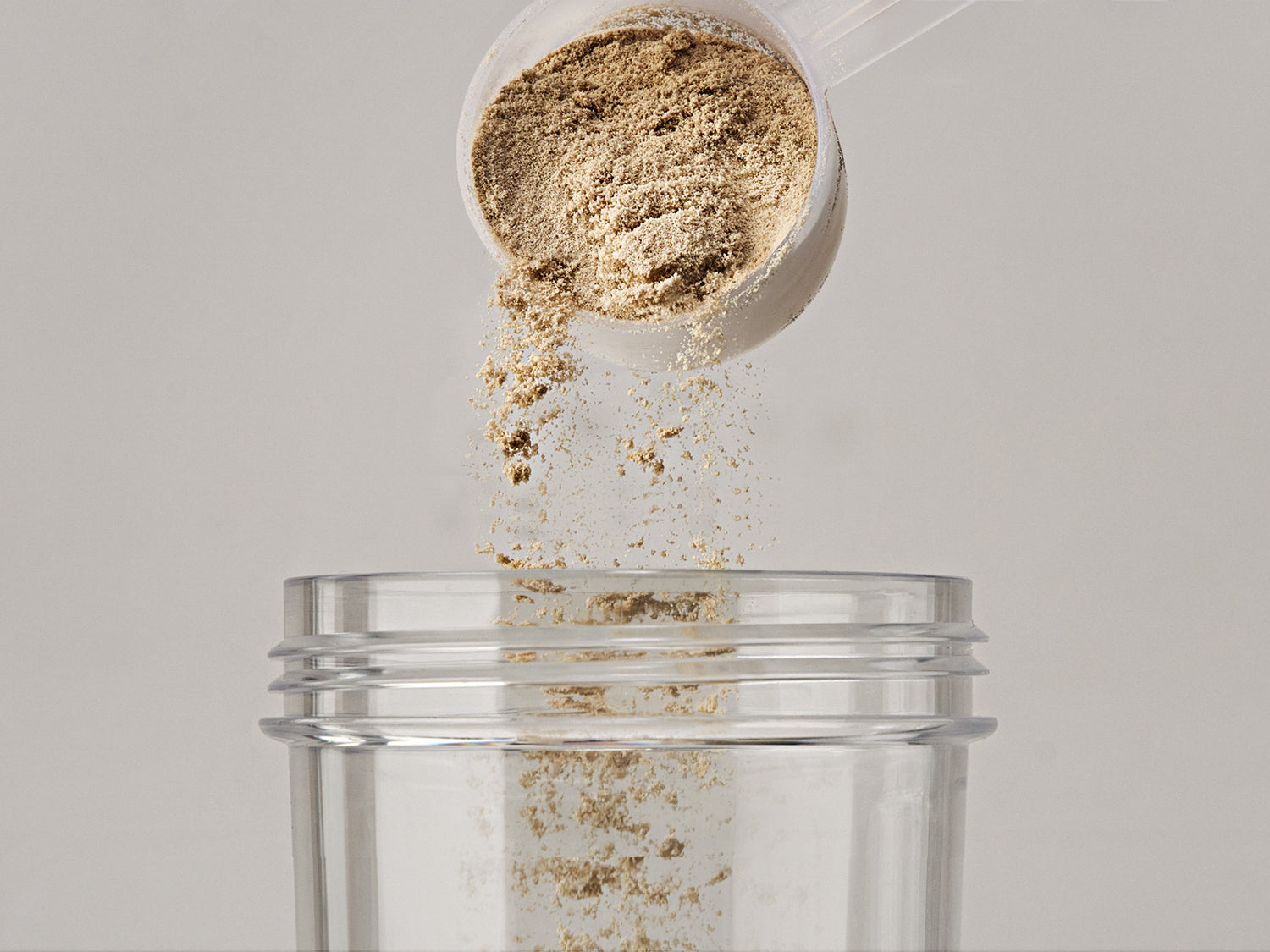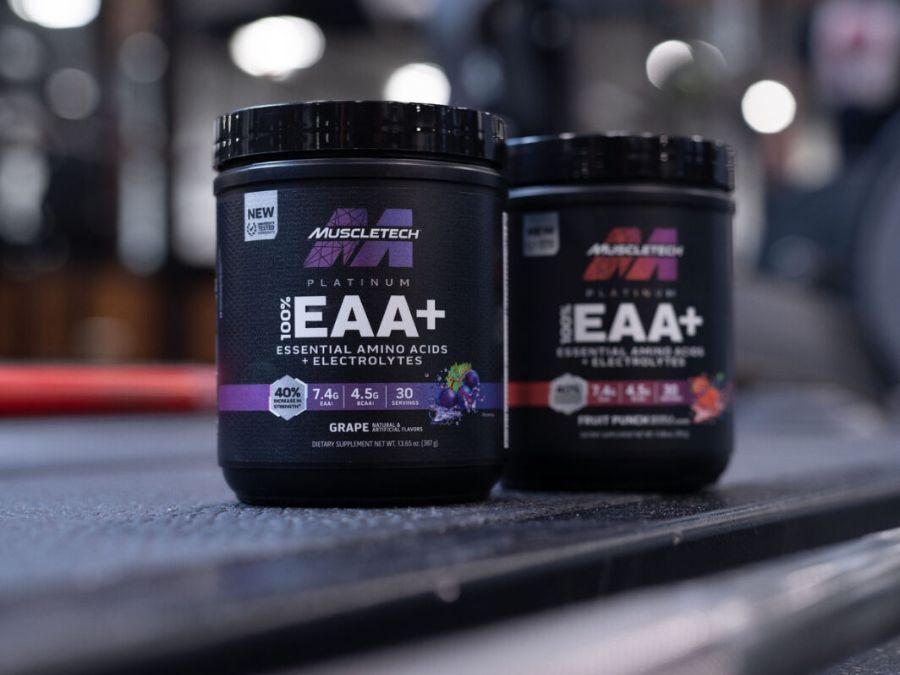In the quest for muscle size, strength and performance, the conversation around dietary supplements often centers on amino acids – the building blocks of protein and muscle.
The debate of BCAAs vs EAAs has commenced.
While Branched-Chain Amino Acids (BCAAs) supplements have traditionally been popular for their muscle-building properties, the spotlight is shifting towards supplements that feature Essential Amino Acids (EAAs).

Buy Premium Quality EAA Supplements
EAAs, comprising all nine indispensable amino acids, offer a more holistic approach to health and performance enhancement. But do they help as much in the gym?
EAAs stand out for their comprehensive benefits, transcending the limited scope of BCAAs. These include not just muscle synthesis, but also overall health and wellbeing. This makes EAAs an essential component for everyone, from fitness enthusiasts pushing their limits to individuals seeking balanced nutrition.
This article delves into why EAAs are increasingly recognized as superior to BCAAs alone. We'll explore the science behind this transition, highlighting how EAAs offer a more complete solution for strength, muscle size, and general health, marking a new era in dietary supplementation.
Amino Acids: The Rundown
Proteins are built from amino acids, and they're pivotal for a slew of bodily functions. Of the twenty amino acids forming these proteins, nine are essential amino acids (EAAs).
The body cannot synthesize these EAAs, and they must be obtained through diet or supplementation, underscoring their importance in nutrition and fitness.
The body can produce the remaining eleven non-essential amino acids, making dietary intake not always necessary for these types. In addition, certain amino acids are considered conditional - typically non-essential, but vital under specific circumstances like stress or illness.
For example, arginine becomes essential during trauma or illness, while glycine is particularly important during pregnancy.
Categorizing aminos by necessity is incredibly useful in prioritizing dietary supplementation. Moreover, it lays the groundwork for comprehending the roles and benefits of EAAs vs. BCAAs.
While BCAAs play a notable role in muscle synthesis and recovery, it's the EAAs that deliver a more complete profile. EAAs, encompassing all nine essential amino acids, are crucial not only for muscle building but also for overall bodily function and health, underscoring their comprehensive importance in any fitness or health regimen.
Also Read: Best Creatine for Women
Exploring EAAs
Essential Amino Acids (EAAs) encompass a broader spectrum than BCAAs, including all nine amino acids our bodies cannot synthesize. They play a critical role in muscle synthesis, recovery, and many other bodily functions. Most importantly for athletes and gymgoers, they are vital for muscle building and the general maintenance and repair of bodily tissues.
EAAs are particularly effective in stimulating muscle protein synthesis. Research indicates that EAAs are more potent in this regard than BCAAs alone. This is because, while BCAAs can aid in muscle repair and growth, they lack the complete profile needed for maximal protein synthesis, and they may even increase catabolism (muscle wasting) when other EAAs are scarce.
Moreover, EAAs have been shown to improve muscle endurance and delay fatigue when supplemented pre-workout. This property makes them exceptionally beneficial for intensive training programs.
Shop & Save on Pre-Workout Supplements
Their rapid digestion and transport directly to the muscles make EAAs ideal for consumption before, during, and immediately following workouts, aligning perfectly with the goals of smashing performance goals and getting the hard gains
The comprehensive benefits of EAAs for exercise and recovery are crucial, especially for gymgoers aiming for peak performance and optimal health. They provide a more complete amino acid profile than BCAAs alone, making them a key component in any athlete's supplementation strategy.
A Brief Overview of BCAAs
BCAAs, comprising leucine, isoleucine, and valine, are a crucial subset of the Essential Amino Acids. They are known for their unique branched chemical structure and are highly regarded in fitness for their role in muscle repair and growth.

Research highlights BCAAs' ability to increase exercise endurance by reducing workout fatigue, a result of their influence on serotonin production in the brain. They also play a significant role in reducing muscle soreness post-exercise, supporting muscle repair, providing energy during workouts, and boosting the immune system.
Leucine, in particular, is noteworthy for its major role in muscle protein synthesis and overall muscle health. It's a key component in triggering the mTOR pathway, which is vital for muscle repair following intense exercise. Additionally, leucine contributes to growth hormone synthesis, blood sugar regulation, and post-injury recovery.
While BCAAs are important, it's essential to recognize that they are just part of the broader spectrum of EAAs needed for comprehensive health and performance. A well-rounded diet is crucial to avoid deficiencies in the other essential amino acids.
Comparative Analysis: BCAAs vs EAAs
A thorough comparison of EAAs and BCAAs is crucial to understanding their distinct roles in muscle growth, strength, and overall health. While BCAAs, particularly leucine, play a significant role in muscle development and lowering the risk of weight gain, their effectiveness pales in comparison to the broader spectrum of benefits offered by EAAs.
Studies have shown that BCAAs can indeed facilitate muscle growth post-resistance training, with one study noting a 22% increase in muscle growth in individuals consuming BCAAs with leucine. However, it's crucial to highlight that this benefit is eclipsed by the results seen in those consuming complete protein supplements, such as whey, which include all nine EAAs.
The superiority of EAAs lies in their comprehensive profile. While BCAAs aid in muscle repair and growth, EAAs contribute to these functions and more, offering a full spectrum of benefits that include enhanced muscle recovery, improved endurance, and better overall health outcomes.
For instance, EAAs have been shown to stimulate protein synthesis more effectively than BCAAs alone, suggesting a more efficient pathway to muscle building and recovery.
Moreover, EAAs play a pivotal role in other physiological processes beyond muscle growth. They are involved in hormone production, immune system support, and metabolic regulation. This makes EAAs not just a fitness supplement, but a cornerstone of general health and well-being.
In contrast, reliance on BCAAs alone can lead to imbalances and potential deficiencies in the other essential amino acids, underscoring the need for a more holistic approach. Supplementing with EAAs ensures that all the necessary amino acids are available for the body’s diverse needs, making them a superior choice for those looking to optimize their physical performance and health.
This comprehensive approach is particularly beneficial when considering the needs of athletes and fitness enthusiasts. For them, EAAs provide the necessary support for both high-intensity training and recovery, making them a more effective and efficient choice in the long run.
Practical Application in the Gym
Integrating EAAs into your supplement regimen is vital for optimal gym performance. EAAs, offering a full spectrum of amino acids, are essential for comprehensive muscle development and overall health, making them ideal for pre- and post-workout consumption.
While BCAAs, particularly those rich in leucine, aid in muscle repair, their benefits are best experienced as a complement to EAAs. Relying on EAAs as your primary supplement ensures a more complete nutrient profile and gives better support to muscle growth, endurance, and recovery.
Balancing these supplements with a varied diet is key to providing all essential amino acids. For fitness enthusiasts, EAAs offer a broader range of benefits, extending beyond muscle development to overall health and wellness.
MuscleTech Brings All the Aminos You Need
For gymgoers seeking to supercharge their workouts, incorporating MuscleTech aminos can be the best supplement decision they ever make. Here are three of their products designed to maximize strength, recovery, and muscle growth, harnessing the power of EAAs.
Platinum 100% EAA+

Platinum 100% EA+ offers an optimized array of EAAs to amplify muscle strength and support protein synthesis.
It’s formulated based on university-conducted research and delivers a unique ratio of EAAs to enhance muscle protein synthesis, strength development, and recovery. Moreover, each serving provides key electrolytes for hydration.
Astoundingly, in a 12-week study, subjects consuming a key ingredient in Platinum 100% EAA+ saw a 40% increase in bench press and a 37% increase in leg press strength. And, for good measure, it also replenishes electrolytes, crucial for maintaining hydration during intense workouts.
Cell-Tech Elite

Cell-Tech Elite is prepared with a highly researched form of creatine and ultra-clean carbs; it comes densely packed with essential muscle builders and added electrolytes.
It features a creatine matrix and PEAK ATP® for heavier reps, with a 12-week clinical study showing an 8.8 lbs muscle gain versus 4.6 lbs in the placebo group – a 90% increase in growth!
The product also supports super-lean muscle building with a combination of BCAAs and EAAs, essential for muscle recovery and strength gains.
Amino Build

Amino Build is scientifically dosed to enhance muscle growth and performance. It supplies the body with critical BCAAs for boosting strength and aiding recovery along with other muscle-building ingredients like betaine anhydrous!
In a clinical study, subjects using the betaine dose found in Amino Build for 6 weeks built 3.75 lbs of lean muscle. This was compared to only 0.66 lbs gained by the placebo group.
The formula also includes a 4g dose of leucine, proven to increase 5-rep max strength by 40%, and taurine, enhancing endurance performance. It’s the perfect extra boost to a supplement program that already includes sufficient EAAs.
BCAAs vs EAAs: The Verdict
In the debate of BCAAs vs EAAs, the evidence points to a clear winner for those serious about their health and fitness: EAAs. While BCAAs have their role, particularly in muscle repair and growth, EAAs offer a more expansive range of benefits that extend far beyond the gym.
EAAs not only encompass the muscle-building capabilities of BCAAs but they include additional amino acids vital for maintaining overall health, hormone balance, and immune system support. They are the full package, necessary for those who seek complete nutrition from their supplements.
For those dedicated to optimizing their workout results and achieving comprehensive health benefits, EAAs are the superior choice. They align with the body's varied needs, supporting a more robust and effective physiological response to exercise. The verdict is in: for the best results in fitness and overall health, a well-formulated EAA supplement is an essential go-to for every gymgoer.
Buy Best Bodybuilding Supplements for Quicker Results
Read More Blogs:
- Diet for Men Over 40: A Comprehensive Guide
- 9 Best Workout Supplements for Beginners
- 10 Best Weight Gain Supplements
- The Ultimate Guide to Protein Powders
Disclaimer
The links used in this article are being provided as a convenience and for informational purposes only; they do not constitute an endorsement or an approval by Iovate Health Sciences International Inc. or any of its affiliates (“Iovate”) of any of the products, services or opinions of the corporation or organization or individual. Iovate bears no responsibility for the accuracy, legality or content of the external site or for that of subsequent links. Contact the external site for answers to questions regarding its content.
References
Church, David D et al. “Essential Amino Acids and Protein Synthesis: Insights into Maximizing the Muscle and Whole-Body Response to Feeding.” Nutrients vol. 12,12 3717. 2 Dec. 2020, doi:10.3390/nu12123717
Cordeiro, L M S et al. “Physical exercise-induced fatigue: the role of serotonergic and dopaminergic systems.” Brazilian journal of medical and biological research = Revista brasileira de pesquisas medicas e biologicas vol. 50,12 e6432. 19 Oct. 2017, doi:10.1590/1414-431X20176432
Drummond, Micah J, and Blake B Rasmussen. “Leucine-enriched nutrients and the regulation of mammalian target of rapamycin signalling and human skeletal muscle protein synthesis.” Current opinion in clinical nutrition and metabolic care vol. 11,3 (2008): 222-6. doi:10.1097/MCO.0b013e3282fa17fb
Fouré, Alexandre, and David Bendahan. “Is Branched-Chain Amino Acids Supplementation an Efficient Nutritional Strategy to Alleviate Skeletal Muscle Damage? A Systematic Review.” Nutrients vol. 9,10 1047. 21 Sep. 2017, doi:10.3390/nu9101047
Jackman, Sarah R et al. “Branched-Chain Amino Acid Ingestion Stimulates Muscle Myofibrillar Protein Synthesis following Resistance Exercise in Humans.” Frontiers in physiology vol. 8 390. 7 Jun. 2017, doi:10.3389/fphys.2017.00390
Kikuchi, Asako M et al. “A systematic review of the effect of L-tryptophan supplementation on mood and emotional functioning.” Journal of dietary supplements vol. 18,3 (2021): 316-333. doi:10.1080/19390211.2020.1746725
Lopez, Michael J. and Shamim S. Mohiuddin. “Biochemistry, Essential Amino Acids.” StatPearls, StatPearls Publishing, 13 March 2023.
Moberg, Marcus et al. “Activation of mTORC1 by leucine is potentiated by branched-chain amino acids and even more so by essential amino acids following resistance exercise.” American journal of physiology. Cell physiology vol. 310,11 (2016): C874-84. doi:10.1152/ajpcell.00374.2015
Negro, Massimo et al. “Essential Amino Acids (EAA) Mixture Supplementation: Effects of an Acute Administration Protocol on Myoelectric Manifestations of Fatigue in the Biceps Brachii After Resistance Exercise.” Frontiers in physiology vol. 9 1140. 17 Aug. 2018, doi:10.3389/fphys.2018.01140
Negro, M et al. “Branched-chain amino acid supplementation does not enhance athletic performance but affects muscle recovery and the immune system.” The Journal of sports medicine and physical fitness vol. 48,3 (2008): 347-51.
Nie, Cunxi et al. “Branched Chain Amino Acids: Beyond Nutrition Metabolism.” International journal of molecular sciences vol. 19,4 954. 23 Mar. 2018, doi:10.3390/ijms19040954
Norton, Layne E, and Donald K Layman. “Leucine regulates translation initiation of protein synthesis in skeletal muscle after exercise.” The Journal of nutrition vol. 136,2 (2006): 533S-537S. doi:10.1093/jn/136.2.533S
Patel, Jayshil J et al. “When Is It Appropriate to Use Arginine in Critical Illness?.” Nutrition in clinical practice : official publication of the American Society for Parenteral and Enteral Nutrition vol. 31,4 (2016): 438-44. doi:10.1177/0884533616652576
Platell, Cameron et al. “Branched-chain amino acids.” Journal of Gastroenterology and Hepatology vol. 15, issue 7 (2001): 706-717.
Qin, Li-Qiang et al. “Higher branched-chain amino acid intake is associated with a lower prevalence of being overweight or obese in middle-aged East Asian and Western adults.” The Journal of nutrition vol. 141,2 (2011): 249-54. doi:10.3945/jn.110.128520
Rasmussen, Betina F et al. “Glycine, a Dispensable Amino Acid, Is Conditionally Indispensable in Late Stages of Human Pregnancy.” The Journal of nutrition vol. 151,2 (2021): 361-369. doi:10.1093/jn/nxaa263
Stoppani, Jim et al. “2009 international society of sports nutrition conference and expo new orleans, la, USA. 14-15 june 2009. Abstracts.” Journal of the International Society of Sports Nutrition vol. 6 Suppl 1,Suppl 1 P1-P19. 31 Jul. 2009, doi:10.1186/1550-2783-6-s1-p1
Witard, Oliver C et al. “Myofibrillar muscle protein synthesis rates subsequent to a meal in response to increasing doses of whey protein at rest and after resistance exercise.” The American journal of clinical nutrition vol. 99,1 (2014): 86-95. doi:10.3945/ajcn.112.055517
Wolfe, Robert R. “Branched-chain amino acids and muscle protein synthesis in humans: myth or reality?.” Journal of the International Society of Sports Nutrition vol. 14 30. 22 Aug. 2017, doi:10.1186/s12970-017-0184-9




